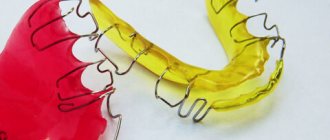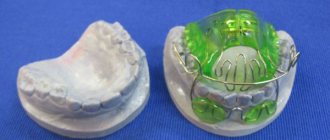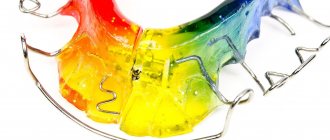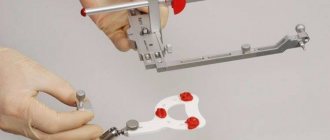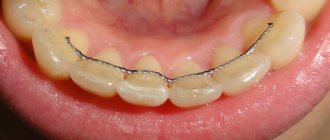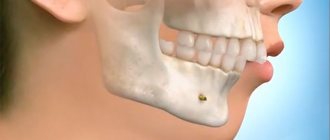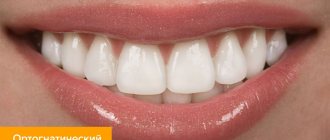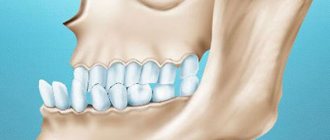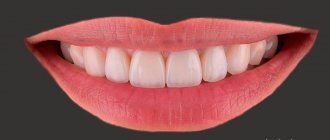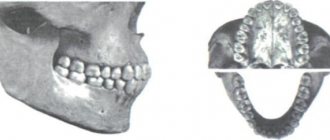Article navigation question for a specialist
A palatal clasp is a device that is used as an addition to any orthodontic structure. As a rule, to braces. The clasp or arch is located on the upper jaw between the molars - the design looks like a rocker. The device allows you to influence the molar chewing teeth, fixing them in a certain position or forcing them to rotate around their axis.
A structure is created from a metal alloy that does not irritate the mucous membrane and surrounding tissues and practically does not cause allergic reactions.
Correction of the bite with reliable metal braces - 72,000 rubles.
All inclusive!
Preparation and treatment of the oral cavity, consultation with an orthodontic specialist, installation and adjustment of orthodontic structures. Color options available for little ones! Go to offer>>> Free consultation with an orthodontist +7 (495) 789-39-31 or write to us
General overview
The Gozgarian apparatus is one of the types of palatal clasps, one might say, their most minimalist version.
The design is a system consisting of 2 bandage rings placed on the molars, and a palatal arch (clasp), connected at its ends to tubes soldered to the rings.
The clasp can have different shapes depending on the task facing the orthodontist. However, most often it is a wire arch curved to the shape of the palate with one bend in the central part.
The device was developed in 1972 by dentist Robert Gozgarian. The first designs were made only individually from stainless steel wire with a diameter of 0.8-1.0 mm, which was soldered directly to the bandage ring.
Currently, the Gozgarian apparatus is manufactured industrially in the form of sets consisting of bandage rings and several standard sizes of palatal arches.
However, in necessary cases, when standard products are not suitable due to the individual characteristics of the jaw structure of a particular patient, the device is manufactured, as in past times - individually.
The main element of the device is the palatal clasp (its function is a wire spring) , made of stainless wire.
Usually the spring has a sigma-shaped bend in the area of the palatal suture (similar to the Coffin spring), which creates a corrective force. However, depending on the task being solved, the bend/bends may be located in a different location.
The ends of the clasp are made in the form of distally located sections, which are double bends of wire with a bent tip.
The double section is inserted into the groove of a lingually located tube soldered to the bandage ring. The bent tip serves as a stop and at the same time as a hook for fixing the clasp to the tube with an elastomeric or wire ligature.
The groove of the tube has a rectangular shape, corresponding to the wire folded in half. The rectangularity of the groove prevents the clasp from turning relative to the tube.
How plates with a Bertoni screw work and the cost of treatment with the devices.
Visit here to find out when a Haas appliance is required in orthodontics.
At this address all the most important things about Persin’s device.
Contraindications
Like any medical product, palatal clasp has its contraindications for use. Their number is small, the list includes:
- mental disorders;
- pathological conditions of the jaw bone tissue;
- Diseases of the immune system.
An examination by an orthodontist and a study of the medical history with which the patient comes to the clinic helps to determine whether a particular patient has them or not. Cases when a doctor decides to refuse to use this device are rare, which makes it possible to widely recommend its installation.
Purpose of the device
The most effective use of the Gozgarian palatal clasp is in children and adolescents aged 7-16 years - after the eruption of the first molars and before the completion of the main stage of formation of the dental system.
Despite its minimalism, the device is multifunctional, and depending on the shape of the clasp, it can have the following effects on the dentofacial apparatus:
- expand the upper jaw in the area of the molars;
- stabilize molars during treatment with other orthodontic devices, for example, braces;
- correct the tortoposition of molars - carry out their deratation, that is, rotate them around a vertical axis;
- normalize their torque (tilt in the vestibular-oral direction);
- move the molars in the mesial-distal direction.
As can be seen from the above description, with the help of the Gozgarian apparatus it is possible to correct the position of the molars in almost all possible directions.
The specific impact of the structure on the molars depends on the configuration of the clasp - the presence and type of bends in different planes. However, the anomalies to be corrected should not be too pronounced.
Design features and operating principle
The palatal clasp, as a device, is in the process of improvement. Fastening methods, types of fasteners and other design details are changing.
The first impression of it is usually negative - it seems that the device is extremely inconvenient and limits a person’s capabilities: it causes speech defects, interferes with chewing food well, and creates discomfort. However, those who went to install this device note that wearing it was unusual only in the first two weeks, then a person gets used to it and stops noticing it. This is facilitated by the small thickness of the wire and the absence of a characteristic metallic taste, since the material is inert and resistant to biological and chemical influences.
The palatal clasp is located between the upper molars, at a short distance from the palate. Its shape is an arc, which is reflected in the name, if translated from German. Its rigidity makes it possible to move the molars into the correct position. They are attached to the frame and change their position over a certain period of time. This is how the bite is corrected; in addition, the molars are strengthened, which the wire arch does not allow to move.
The palatal clasp is intended, first of all, to form a correct bite; it affects the position of the molars. They have roots that are too strong for plates or braces to handle. In addition to correcting the bite, fixation of molars is carried out in cases where their movement is possible, for example, as a result of injury or surgery.
The decision to use a palatal clasp is made by an orthodontist, who examines the patient and determines the condition of the oral cavity. The procedure includes an orthopantomogram of the teeth. In some situations, the clasp is used in combination with expanders, which are involved in changing the shape of the upper jaw. These devices are fastened in a similar way; expansion is possible due to the presence of a sliding element.
Main characteristics
Visually, the Gozgarian apparatus consists of two rings placed on the permanent molars, “spread open” by a palatal clasp, attached at their ends to the tubes of the bandage rings.
Each element of the device performs its own function:
- Palatal clasp . This is the main force element that creates force, the magnitude and nature of which depends on the shape, direction and size of the bends.
- Double ends of the clasp . Serve to fix the arc in the lock tubes.
- Bandage rings . They transmit force from the tubes to the molars.
- Elastomeric or wire ligature a. Fixes the ends of the clasp in the tubes of the locking device.
According to the principle of operation, the Gozgarian apparatus belongs to orthodontic devices that use reciprocal support. That is, the correction force is at the same time a reactive supporting force that pushes the molars away from each other.
There is no stationary support in Gozgarian's design, which can be considered as one of the disadvantages limiting the functionality of the device.
The correct functioning and effectiveness of the device largely depends on the skill of the orthodontist in its manufacture and activation. Each bend of the clasp can have a complex effect on the molars - linear, rotating or combined.
It depends on the professionalism of the orthodontist whether this effect will be correct or will lead to an effect opposite to what is required.
Evaluate the results of bite correction using the Biederman appliance using before and after photos of patients.
In this publication, we will consider the design features of the FNTA.
Here https://zubovv.ru/ortodontiya/plastinyi/apparat-alf-ispravlenie-prikusa.html find out how popular the ALF system is in orthodontics.
Manufacturing stages and installation
The most convenient, hassle-free option for using the Gozhgarian apparatus is to purchase an industrial design consisting of bandage rings and a set of 5-7 palatal clasps of different sizes.
The main parameter is the distance between the lingual surfaces of the molars. Typically this parameter is presented in sizes of 34, 37, 41, 45, 47, 49 and 52 mm.
Industrial palatal clasps can be installed without correction or adjusted, if required, to a specific jaw.
If the anatomical features of the latter do not allow the use of a standard design even after modification, the Gagarin apparatus is made individually in the dentist’s office and/or clinic laboratory.
Two methods of individually manufacturing the device are used - with the installation of bandage rings on a plaster model and without installation.
In the first case, after taking impressions from the jaw and molding a plaster model based on them, the manufacture, fitting and modification of the apparatus from start to finish is carried out on a plaster model with bandage rings installed on it.
In the second case, the rings are immediately installed on the patient’s molars, an impression is taken from the jaw, a plaster model is formed containing the imprint of the bandage rings, and a palatal arch with approximate dimensions is made on it.
Fitting and final fitting are carried out directly in the patient’s mouth in the orthodontist’s office.
This method eliminates the installation of bandage rings on a plaster model, saves time, but requires more professionalism from the doctor.
The installation of bandage rings on the patient’s molars is carried out in the following sequence:
- A week before fixing the appliance, separation elastomeric rings are installed on the molars, creating an interdental gap for the bandage rings.
- After the device is manufactured (see below), the separation rings are removed, the teeth are dried, covered with composite glue, bandage rings are installed on them, and the composite is photopolymerized.
In its other details, the production of the Gozgarian palatal clasp, starting from the moment of making the plaster model, remains the same, and consists of the following steps:
- Applying basic marks to the plaster model - lines passing along the end of the tubes and the axis of the dental arch passing along the palatal suture.
- The distance between the tubes is measured taking into account the curvature of the palate. The length of the arc is taken to be a distance 2 mm less than measured. This is necessary so that the arc is 1.5-2 mm from the mucous membrane of the palate.
- From a standard arch taken as a blank, an Omega loop is formed in the center of the arch using Weinhart forceps.
- At the ends of the arch, double sections with bent stops are created, intended for installation in tubes. The shape and dimensions of the palatal arch must correspond to the structural features of the palate, alveolar process and the base lines marked on the model. The double ends of the arcs must fit into the tubes freely.
- The palatal clasp is fitted to the tubes of the bandage rings installed in the patient’s mouth. If necessary, the arc is adjusted. At this stage, the clasp is not yet activated, and should enter the tube passively, without tension.
- The clasp is activated (expansion of the sigma-shaped central ring or other bend), the ends of the arc are inserted into the tubes, and they are fixed with a wire or elastomeric ligature.
The installation of the Gozgarian apparatus is completed by issuing recommendations on the rules of care for the device and the oral cavity, and communicating a schedule for visiting the doctor in order to activate the apparatus and monitor the progress of treatment.
The video shows the process of making a palatal clasp.
What does the installation process look like?
Bite correction can be carried out efficiently only if you contact a professional. Installation of Gozgarian equipment is carried out in licensed orthodontic clinics. The process consists of several stages.
- The doctor's consultation. The specialist will determine the presence of contraindications and select the appropriate method of bite correction. If you have certain diseases of the oral cavity or teeth, the doctor will prescribe treatment.
- Selection of design. The doctor will take measurements of the jaw and determine the dimensions of the apparatus necessary for correction. At this stage, the exact date for the procedure will be set.
- Preparatory stage. Immediately before the procedure, the doctor sanitizes the oral cavity. Tooth sensitivity is checked.
- Installation of the device. The process of attaching and setting up the structure is carried out within 30-40 minutes.
- Quality checking. If there are installation defects, the doctor will correct them on the spot. Then he will schedule a follow-up consultation to assess the quality of the orthodontic appliance.
Pregnancy and lactation are not contraindications to treatment using the Gozgarian device, because the use of medications in this case is excluded. Despite this, consultation with a doctor before installing the device is mandatory!
Another feature of the device is that it can be used by patients of almost any age. You can learn more about modern possibilities for correcting malocclusion in adults from the final video.
Side effects
The disadvantages of the Gozgarian apparatus include the lack of absolute support, and the ability to be used mainly as an auxiliary element in conjunction with main orthodontic devices.
The use of a palatal clasp is accompanied by the following undesirable phenomena:
- Speech impairment. Although the device is extremely compact, the first time after installation the tongue still clings to it, distorting pronunciation. After getting used to it, this negative aspect usually disappears.
- Deterioration of oral care conditions due to stuffing food under the structure, especially in the area of locks. When using palatal clasps, the use of an irrigator is recommended.
- Possible allergy to the metal of the arch and bandage rings with tubes.
- High requirements for the qualifications of the doctor for the correct manufacture and activation of the device.
In addition to the disadvantages described above, independent use of the device allows you to eliminate only slightly pronounced anomalies.
Palatal clasp: varieties
One of the types of clasp is the palatal expander. This is a cross-shaped structure made of metal wire, designed to expand the upper jaw. The sliding part of the apparatus is located in its center, at the intersection of the wires.
You need to wear this extender for about four to five weeks, although results become noticeable after an average of 3 weeks. While using the device, a gap may appear or widen between the front teeth, but there is no need to worry - this is a temporary phenomenon, braces will correct this deficiency. Apart from slight discomfort at first after installation, the expander usually does not cause pain in the patient.
Another type of clasp is Quadrohelix. This is a device that is used either on its own or before starting primary orthodontic treatment. It allows you to change the position of some teeth that usually require removal, as well as lengthen the dentition for a complete and high-quality displacement of teeth after installing braces.
Advantages of the design
Despite the side effects listed above, the Gozgarian palatal clasp has obvious advantages , which allows it to remain widely in demand among orthodontists:
- First of all, this is a good “efficiency + price” parameter. Due to its compactness and ease of manufacture, the Gozgarian palatal clasp costs disproportionately less than a bracket system, for example. The cost of a device with bandage rings is about 5,000 rubles. You can purchase a separate palatal arch for 500 rubles.
- Quick adaptation to the design due to its minimalism.
- Practical invisibility.
- The simplicity of the arch design, the ability to make it yourself in any dental laboratory.
Palatal clasp: disadvantages
The main disadvantage of the palatal clasp is minor injury to the tongue and deterioration of diction in the first time after installation. Due to the metal wire on the roof of the mouth, the tongue cannot “work” in the usual way, which affects the distortion of some sounds. However, after two to three weeks the patient fully adapts to the device.
To reduce the adaptation time, the orthodontist may advise you to train your speech yourself, speak more, especially pronounce tongue twisters.
Price
| Service name | Price |
| Positioner | 30,000 rub. |
| Plate with screw and/or teeth | 14,000 rub. |
| Soldered device with rings and screw for distalization of molars | 28,000 rub. |
All prices for services
Expected Result
To summarize, it is necessary to note the undoubted usefulness of the Gozgarian apparatus, which consists in the ability to correct a mildly pronounced anomaly with minimal financial expenses and discomfort for the patient.
In more complex cases, the palatal clasp can be used simultaneously with other orthodontic devices. This will reduce the overall treatment time and significantly reduce financial expenses.
It is only necessary to correctly assess the capabilities and purpose of the device, and take a professional approach to its manufacture, installation and activation.
Reviews
Palatal clasps are devices that, when used correctly, show an unexpectedly high effect despite their modest appearance.
If your child or you yourself had to wear a Gozgarian design, share your impressions of this interesting device.
How did the addiction go, how long did the treatment last, what was the result? You will find the feedback form at the bottom of this page.
If you find an error, please select a piece of text and press Ctrl+Enter.
Tags devices: bite correction
Did you like the article? stay tuned
No comments yet
Palatal clasp: rules of use
The palatal clasp must be worn without removing it for approximately three months (individual adjustments for the period are necessary for each patient). After installation, you must periodically visit the orthodontist to monitor the treatment process. When wearing a clasp, you need to carefully monitor your diet, since the wire structure in the mouth can interfere with normal food intake.
Caring for a palatal clasp is no different from caring for other orthodontic appliances. Thorough oral hygiene, temporary avoidance of sticky, hard foods, daily independent and periodic examination of the structure by an orthodontist - all this will help reduce any complications to zero.
